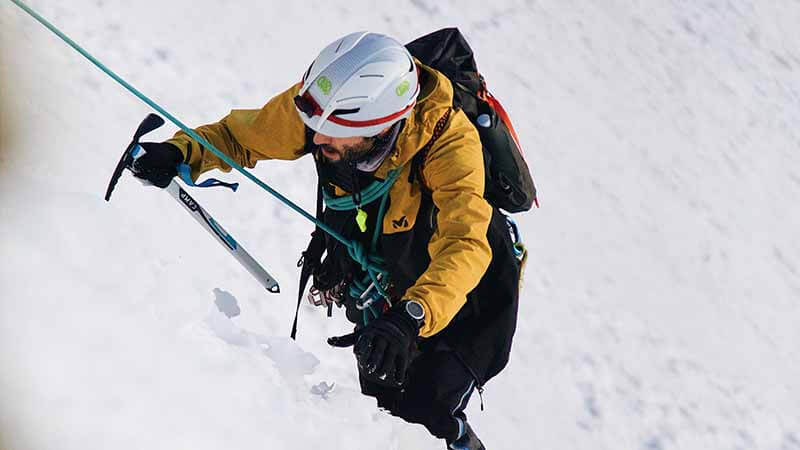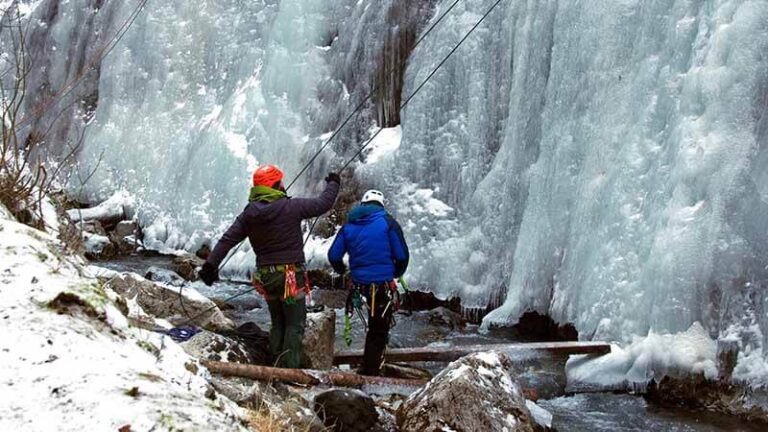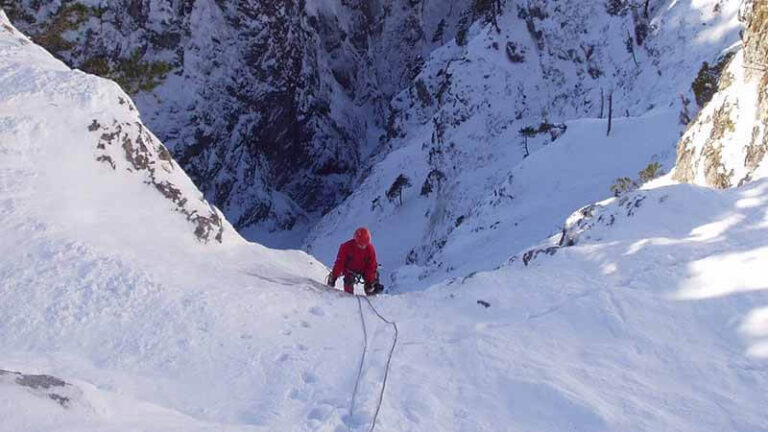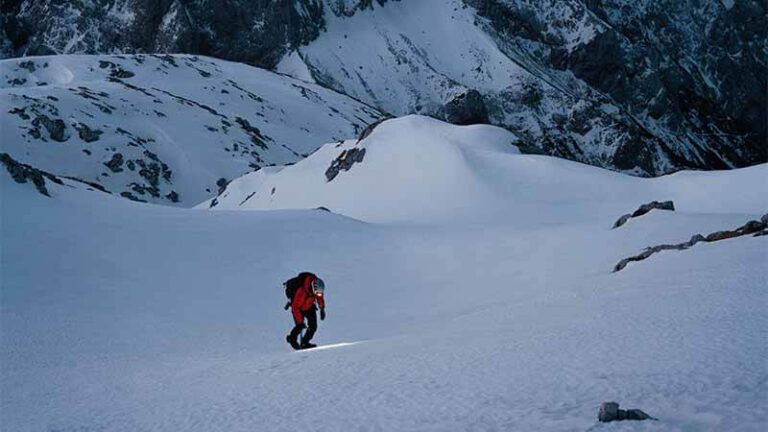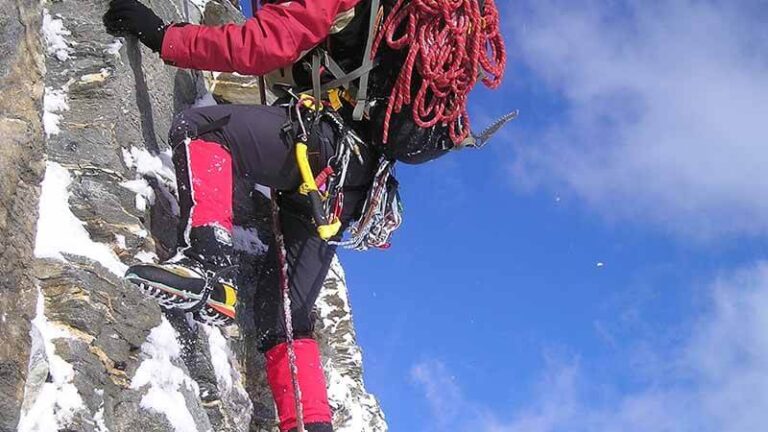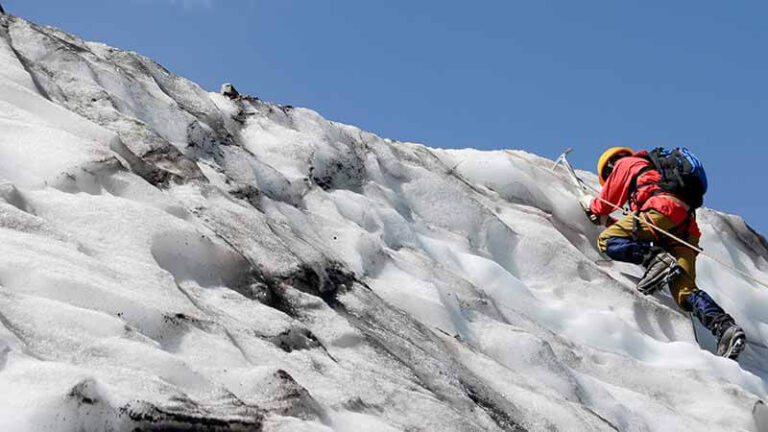The Ultimate Guide to Ice Climbing Axes
Ice climbing, a type of mountaineering, opens you a thrilling world of adventure amid some of nature’s most punishing and intriguing environments. It’s a sport that requires a unique combination of physical power, mental toughness, and technical expertise.
Ice climbers immerse themselves in a world of sparkling ice structures and beautiful winter panoramas as they scale frozen waterfalls and glaciers. This extreme sport has grown in popularity not just among adrenaline addicts, but also among those looking for a deep connection with nature and a true test of their limitations.
The Vital Role of Ice Climbing Axes
Ice climbing axes are a collection of tools that are literally a climber’s lifeline at the heart of the ice climbing experience. These specialized tools serve as the climber’s principal interface with the icy terrain they cross.
Ice climbing axes provide stability, control, and the capacity to arrest falls on icy terrain, in addition to being a means of upward movement.
They function as an extension of the climber’s body, allowing them to confront difficult ice formations and overcome frozen obstacles that would otherwise be unreachable. Ice climbing axes are without a doubt the unsung heroes of this thrilling sport.
Why Choosing the Right Ice Climbing Axe Matters
Choosing the right ice climbing axe isn’t just a matter of taste; it’s a decision that can make or break an ice climbing excursion. The repercussions of selecting the incorrect axe might vary from decreased performance and tiredness to major safety risks.
When considering criteria such as the kind of climbing terrain, individual ability level, and the specific needs of each climb, the necessity of selecting the correct ice climbing axe becomes clear.
A well-chosen ice axe can improve a climber’s ability to handle steep ice walls or mixed routes, giving them the confidence and control they need in this high-risk sport.
Furthermore, the appropriate axe can have a major impact on comfort and endurance, allowing climbers to push their limits without jeopardizing their safety. In summary, the selection of an ice climbing axe is a critical decision that influences the overall ice climbing experience.
Types of Ice Climbing Axes
Understanding the many varieties of ice climbing axes is vital for picking the correct equipment for the job when stepping into the captivating world of ice climbing. There are two types of ice axes: technical ice axes and common mountaineering axes.
Each serves a certain purpose and excels in certain situations, providing climbers with versatility and adaptability to various ice and mixed terrain obstacles.
Technical Ice Axes
Purpose and Use
Technical ice axes are handcrafted instruments designed to meet the challenges of high-ice climbing. They have a design that is intended for gripping and penetrating hard ice, and they enable improved control and precision when placing.
Their major aim is to provide ice climbers with the confidence to engage with frozen surfaces, allowing them to ascend vertical ice walls and navigate intricate ice formations.
Features and Design
Technical ice axes are distinguished by numerous fundamental design aspects. They frequently have a curved shaft, which allows for an ergonomic grasp and precise ice placement.
For secure penetration and stability, these axes have aggressively curved picks with toothed edges. They may also feature a supplementary hammer or adze for added adaptability in mixed terrain or ice climbing conditions.
Ideal Terrain for Technical Ice Axes
Technical ice axes excel in steep ice terrain where precise placement and control are essential. These axes thrive in vertical icefalls, ice couloirs, and frozen waterfalls, allowing climbers to tackle difficult routes with confidence.
Because they are designed for steep ice, they are less ideal for general mountaineering and better suited to specific ice climbing attempts.
General Mountaineering Axes
Purpose and Use
General mountaineering axes, sometimes known as “mountaineering ice axes,” provide climbers with a versatile and multipurpose instrument for a variety of alpine and mixed climbing situations.
While they do not have the specific capabilities of specialist ice axes, they are intended to give balance and support in a variety of alpine conditions.
Features and Design
Technical ice axes often have a straighter shaft and a less aggressive pick design. The pick may have a larger head, often with a larger adze or hammer. Because of this, they can be used for self-arrest on snow slopes, chopping steps, and regular climbing chores. In addition, they are more comfortable to use as walking sticks during approaches.
Ideal Terrain for General Mountaineering Axes
Axes designed for general mountaineering are ideal for less steep ice and mixed terrain, glacier travel, snow-covered slopes, and alpine ascents. They give the necessary stability for traversing snowy ridges and are good for self-belay and self-arrest on moderate slopes. Because of their adaptability, they are a crucial tool for climbers addressing a wide range of mountain obstacles.
Anatomy of an Ice Climbing Axe
Understanding the numerous components of an ice climbing axe is vital when venturing into the world of ice climbing. These axes are specialized instruments for navigating the difficult and occasionally perilous terrain of ice-covered surfaces. Their anatomy is made up of numerous fundamental components that are critical to a climber’s safety and performance.
Pick
Blade
The blade, also known as the pick, is the front portion of an ice climbing axe and serves as the primary point of contact with the ice. It usually has a sharp, serrated edge with teeth or spikes that are designed to cut into the ice. The blade’s ability to penetrate and securely hold the ice is critical for stability and control during climbs.
Adze
The adze is a flat, blade-like protrusion on the pick’s reverse side. It is utilized for operations such as ice or snow removal, chopping steps, and anchor placement. The size and shape of the adze differ amongst ice axes, and its existence can increase the adaptability of an ice climbing axe, making it appropriate for a larger range of jobs.
Hammer
On the other side of the adze, some ice climbing axes have a hammerhead. The hammer can be used to pound pitons, lay anchors, or as a tool in mixed climbing situations. This feature improves the axe’s utility in a variety of climbing situations.
Shaft
Material
The shaft of an ice climbing axe can be made of a variety of materials, the most common of which being aluminum and carbon fiber. The material influences the weight, durability, and flexibility of the axe. Aluminum shafts are long-lasting and have a good strength-to-weight ratio, whereas carbon fiber shafts are lighter and have better shock absorption.
Length
Ice climbing axe shafts are available in a variety of lengths to meet a variety of climbing styles and preferences. Longer shafts give more leverage and are therefore better suited for steep ice and complex climbing. Shorter shafts are more adaptable and nimble, making them excellent for alpine or mixed terrain where precise positioning and swinging clearance are critical.
Ergonomics
The shaft’s design and shape are crucial for comfort and performance. Ergonomic shafts are curved to comfortably fit the hand and provide a secure grip during climbs. Ergonomics is important in decreasing strain and ensuring precise control of the axe.
Grip
Design
Ice climbing axe grips come in a variety of styles, including straight or curved handles. Personal preference and the style of climbing are frequent factors in grip design selection. Curved grips are better for steep ice climbing, whilst straight grips are more versatile for mixed terrain.
Comfort
When it comes to the grip of an ice climbing axe, comfort is essential. Climbers must sustain a strong grasp for extended periods, and pain or hot places can lead to decreased performance and exhaustion. To ensure a pleasant and solid grip, grips are often cushioned or molded.
Leash or No Leash
Pros and Cons
The decision to climb with or without a leash is a matter of personal preference and climbing style. Leashes provide security by keeping the axe from falling in the event of a fumble or fall.
They can, however, limit movement and certain techniques. Climbing without a leash provides more freedom of movement and may be more efficient for some climbers, but it increases the risk of losing the axe.
Key Features to Look for in Ice Climbing Axes
Choosing the best ice climbing axe requires more than just understanding its fundamental components. Climbers should also evaluate the key qualities that distinguish one axe from another when making an informed decision since these features can have a big impact on their overall climbing experience.
Materials and Construction
Importance of Materials
The materials utilized to make an ice climbing axe are crucial to its performance and longevity. Axes are commonly composed of materials such as aluminum, carbon fiber, or steel.
Aluminum is valued for its lightweight and durability, whilst carbon fiber axes excel at stress absorption. Steel axes are extremely durable and strong, making them ideal for difficult ice and mixed terrain.
Understanding these material properties allows climbers to select an axe that best suits their climbing style and needs.
Durability
In ice climbing, where instruments are subjected to extreme conditions, durability is critical. The ability of an axe to survive repeated use and collisions against hard ice is critical for long-term dependability.
Climbers should evaluate the axe’s materials, manufacturing quality, and build to ensure that it can withstand the rigors of ice climbing without compromising safety or performance.
Weight and Balance
Weight Distribution
Weight distribution is critical to the handling and maneuverability of an ice climbing axe. Axes with a well-balanced weight distribution are less tiring to operate and easier to handle. Climbers with a balanced axe can make precise placements and maintain control on steep ice or mixed routes, improving overall climbing efficiency.
Impact on Performance
The weight of an ice climbing axe can have an effect on a climber’s performance, particularly on long ascents. Lightweight axes lessen arm and shoulder strain, allowing climbers to maintain strength and precision for longer periods.
Heavier axes, on the other hand, can provide more force and penetration on difficult ice, but they may cause tiredness more quickly. The choice between weight and balance is determined by the climber’s style and goals.
Modular Design
Customization Options
Some ice climbing axes are modular in construction, allowing climbers to tailor their tools to certain climbing circumstances. Climbers can adapt to changing terrain by using modular axes with replaceable picks, adzes, or hammers.
This adaptability can be a substantial benefit since climbers can invest in a single set of axes that can be adjusted to different climbing scenarios.
Versatility
Ice climbing axes’ modular construction increases their versatility, making them ideal for a wider range of climbing challenges. Climbers can change tool configurations, optimizing their axes for specific jobs such as steep ice, mixed routes, and alpine ascents. This versatility can be very useful for climbers who explore a variety of terrains.
CEN Ratings
Understanding Safety Standards
CEN ratings are standardized safety certifications used to evaluate the performance and safety of climbing equipment, especially ice climbing axes. Understanding CEN ratings is critical for determining an axe’s suitability for various applications.
Axes are classified into different classes based on their intended use and performance on standardized testing. Climbers should be aware of these ratings to make informed decisions about the safety and dependability of their gear.
Impact on Decision-Making
CEN ratings help climbers choose the best ice climbing axes for their specific activity. Axes with higher CEN ratings are intended for more difficult and technical climbing, whereas those with lower ratings are better suited for less difficult terrain.
Climbers must examine these ratings alongside their ability level and climbing objectives to ensure they select axes that fulfill safety standards and are appropriate for their skills.
How to Choose the Right Ice Climbing Axe
Choosing the best ice climbing axe is a critical decision for climbers since it directly affects their performance, safety, and overall experience on the ice. When selecting the best ice climbing axe, several critical variables must be considered.
Skill Level and Experience
Axes for Beginners
Novice climbers should use ice climbing axes developed for novices. These axes often have a simpler design that emphasizes ease of use and forgiveness. They’re great for learning the fundamentals of ice climbing and gaining confidence on the ice.
Axes designed for beginners typically feature a less aggressive pick design, which makes them less prone to catching on the ice and provides a smoother learning curve.
Intermediate and Advanced Axes
Climbers may seek more specialized tools as they gain experience and expertise. Ice climbing axes can aid intermediate and experienced climbers by improving precision, versatility, and performance in difficult situations.
These axes frequently have more aggressive picks and ergonomic designs that are tailored to the needs of experienced climbers. Climbers using advanced axes can confidently test their boundaries and explore more difficult routes.
Climbing Style
Ice Climbing vs. Mixed Climbing
The climber’s desired style should be considered while selecting an ice climbing axe. Ice axes with curved shafts and aggressive picks are appropriate for those who are primarily interested in ice climbing.
These instruments provide the control and precision required for dealing with frozen waterfalls and vertical ice. Mixed climbers, on the other hand, should look for axes that are versatile, with modular designs that allow for the installation of hammers and adzes as needed.
Alpine Climbing Considerations
Alpine climbers frequently face difficult terrain, such as ice, snow, and rock. Alpine climbing axes should be lightweight and have straighter shafts for efficient self-belay and self-arrest on snow slopes.
In alpine conditions, where climbers may face a variety of challenges on a single ascent, modular axes that can adapt to varied scenarios are advantageous.
Budget Considerations
Entry-Level vs. High-End Axes
Budget limits can have an impact on ice climbing axe selection. Entry-level axes are less expensive and provide a cost-effective way for beginners to begin ice climbing.
These axes have features that are crucial for learning and practicing ice climbing methods. High-end axes, on the other hand, are made with modern materials, precision engineering, and specialized features to fulfill the expectations of expert climbers.
When deciding between entry-level and high-end solutions, climbers should consider their money as well as their long-term dedication to the sport.
Value for Money
When choosing ice climbing axes, climbers should seek a balance of price and value. While it may be tempting to choose the most costly axes available, it is critical to weigh the features, durability, and versatility of an axe in proportion to its price. The goal is to invest in an axe that fits the needs of the climber without exceeding their budget.
Ergonomics and Comfort
Importance of Personal Fit
Ice climbing axes must be comfortable to hold in the climber’s hand for lengthy periods. The grip and shaft design ergonomics are critical for preventing fatigue and maintaining control.
Climbers should select axes that feel comfortable and secure in their hands, as discomfort or odd grips can impair performance and safety.
Testing and Trying Axes
Climbers are encouraged to experiment with various ice climbing axes whenever possible. This hands-on experience allows students to evaluate how an axe feels in their hands, how it responds to their movements, and whether it is appropriate for their style and preferences.
Climbing shops, gear rental centers, and opportunities to try out equipment can all help you make an informed decision.
Terrain and Conditions
Matching Axes to Specific Climbing Environments
Climbing axes should be tailored to the settings and situations that a climber plans to face. Axes designed for steep ice may not work well on varied terrain, and vice versa. Understanding the planned climbing terrain and the unique obstacles it poses is critical for choosing the appropriate tool.
Adaptability for Changing Conditions
Climbers should also examine how well their ice climbing axes adjust to shifting conditions. An axe with many picks or attachments provides versatility, allowing climbers to adapt their equipment to the changing demands of the climb. This versatility ensures that a single pair of axes can function effectively in a variety of situations and terrains.
Maintenance and Care of Ice Climbing Axes
Ice climbing axes must be properly maintained and cared for to ensure their longevity, function, and, most importantly, your safety while traversing icy terrain. Ice climbing axes are precision instruments that can wear out over time due to repeated usage, exposure to severe weather, and the demanding nature of the sport. Here’s a detailed guide to maintaining and caring for your ice climbing axes.
Cleaning and Lubrication
Cleaning and lubricating your ice climbing axes after each usage is an essential part of care. Ice, snow, and moisture can build up on the pick and shaft, causing rust and reduced performance. Follow these procedures to keep your axes in good condition:
- Clean the pick, adze, and shaft of any ice, snow, or debris.
- Wipe the axe down with a dry cloth to remove any excess moisture.
- Apply a thin layer of rust-preventative lubricant on the pick and other metal components, giving special attention to the pick’s teeth.
- Make certain that the adze and hammer are clean and free of ice and snow.
Inspection and Maintenance Schedule
Inspecting your ice climbing axes regularly is critical for detecting wear and fixing any potential concerns before they jeopardize safety. Create a maintenance schedule that contains the following items:
- Examine the pick’s condition and the sharpness of the teeth. To maintain good penetration, sharpen or replace the pick as needed.
- Look for signs of deterioration, such as cracks or bends, on the shaft. Replace any damaged or compromised shafts as soon as possible.
- Examine the grip and leash attachment points to verify they are secure.
- Look for any loose or damaged parts, such as bolts or nuts. As needed, tighten or replace them.
- Examine the adze and hammer for any chips or cracks. If these components exhibit indications of wear, they should be replaced.
Storage and Transport Tips
Ice climbing axes must be stored and transported properly to avoid damage and retain performance. Follow the following guidelines:
- Keep your axes in a cool, dry location to avoid rust and moisture buildup.
- Avoid intense sunshine and severe temperatures, which can deteriorate materials over time.
- When transporting or storing your axes, use protective coverings or guards to prevent unintentional damage to other gear or equipment.
- Avoid storing or transporting large objects on top of your axes, as this might cause distortion or damage to the shaft and components.
Common Problems and Solutions
Despite proper maintenance, ice climbing axes can develop frequent issues that necessitate repair. Here are some common problems and their solutions:
- Rust: If you find rust on your axe, use a wire brush or fine sandpaper to remove it. Clean and lubricate the damaged area afterward to prevent future rusting.
- Loose Components: Using the proper tools, tighten loose bolts, nuts, or attachments. To keep the axe’s integrity, make sure they’re properly fastened.
- Blunt Pick: Use a file or specialized sharpening tool to restore the pick’s sharpness for better ice penetration.
- Shaft Damage: Replace the shaft promptly if it is compromised, such as cracked or bent, to eliminate safety risks while climbing.
- Leash Wear: Replace your leash if it exhibits indications of wear, such as fraying or damage, to ensure a strong connection between you and your axe.
By following these ice climbing axe maintenance and care techniques, you can extend their lifespan, maximize their function, and ensure a safe and enjoyable ice climbing session. Regular inspections and maintenance are essential for keeping your tools in top shape for your next snowy excursion.
Tips for Safe and Effective Ice Climbing
Ice climbing is an exhilarating but fundamentally dangerous sport that demands careful planning, skill, and safety procedures. Climbers should follow a series of fundamental tips and practices to ensure a safe and successful ice climbing experience.
Proper Use of Ice Climbing Axes
The proper use of ice climbing axes is critical for both safety and performance. Climbers should:
- Make sure their ice axes are securely planted in the ice, with good penetration and stability. Keep an eye on the placement angle to avoid overhanging ice or brittle parts.
- Maintain a relaxed grasp: A stiff grip might cause tiredness. Hold the axe firmly but not too tightly to allow for flowing movements.
- Make precise swings: Use precise swinging methods to save energy and avoid unwanted chipping or damage to the ice.
- Practice leash use: If you use leashes, learn how to attach and unhook them efficiently and safely. Maintain complete command of your tools at all times.
Safety Precautions
Ice climbing should prioritize safety. Important safety considerations include:
- Check your equipment regularly: Inspect your ice climbing axes, harness, rope, and other equipment for wear, damage, or malfunction before each climb.
- Put on appropriate clothing: Dress in layers to keep your body temperature stable and avoid hypothermia. Check that your clothing provides insulation and protection from the cold and wetness.
- Wear a helmet: To protect your head from falling ice or debris, wear a climbing helmet.
- Carry the following safety equipment: In case of an emergency, include vital safety equipment such as a first aid kit, communication device, and rescue gear.
- Study and practice self-rescue strategies such as: Dealing with unforeseen scenarios, and practicing self-rescue skills such as crevasse rescue and ascending ropes.
Communication and Teamwork
Ice climbing requires effective communication and teamwork:
- Create distinct signals: Create a set of communication signals with your climbing partner(s) to relay critical information, such as route alterations or potential hazards.
- Distribute roles throughout your climbing team, ensuring that each member understands their role in the ascent and descent.
- Maintain situational awareness: Evaluate the circumstances, route, and surroundings on a regular basis, exchanging insights with your team to make educated decisions.
Training and Skill Development
It is critical to invest time in training and skill development:
- Seek expert instruction: To acquire proper methods and safety measures, enroll in ice climbing courses or hire a trained guide.
- Practice on a variety of terrain: To improve your skills and confidence, gradually go from easier to more difficult ice routes.
- Strength and endurance training: Because ice climbing requires physical conditioning, add strength and endurance training into your regimen to increase your climbing ability.
- Acquire the skills to analyze ice quality, identify potential hazards, and make informed judgments based on the conditions.
Conclusion
To summarize, ice climbing is a sport that draws travelers into a captivating realm of frozen wonders, taxing both body and mind. The ice climbing axes, our steadfast friends on this vertical trip, are crucial to this wonderful endeavor.
Climbers can begin on their icy voyage with confidence if they grasp the types, anatomy, vital features, and how to select the correct ice climbing axe.
Maintenance and care of these valuable instruments are critical to ensuring they remain in top shape for countless ascents. Safety precautions, efficient communication, and skill development highlight the significance of a well-rounded approach to ice climbing, not just for conquering the ice but also for securely enjoying its awe-inspiring beauty.
Finally, ice climbing axes are more than simply equipment; they serve as a link between our dreams and the spectacular ice formations that await us. Ice climbers with the correct knowledge, abilities, and respect for the sport can create unique moments and deeper connections with nature’s frozen beauties.
So, as you set out on your ice climbing excursions, remember to walk lightly, climb cautiously, and experience the fascinating world that ice climbing reveals. May your ascents be thrilling, your accomplishments be spectacular, and your love for the icy heights remain.

